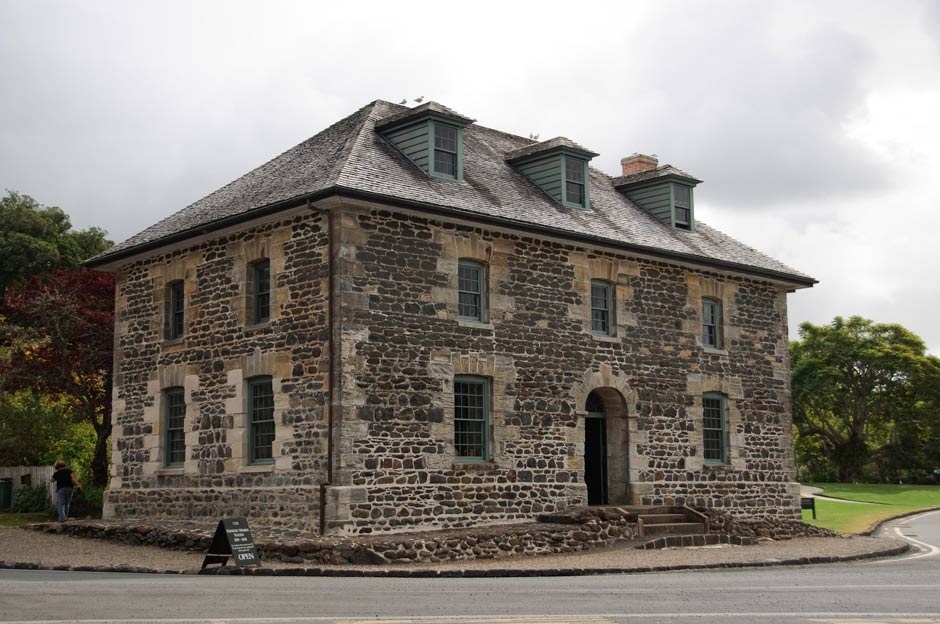
Stone Store (1835)
CMS white elephant
The Stone Store was New Zealand’s first architectural white elephant. Modelled, like the adjacent mission house, on Samuel Marsden’s establishment at Parramatta, in Sydney, the store testifies to the determination of Church Missionary Society (CMS) catechist, storekeeper and blacksmith James Kemp and his wife Charlotte not to leave their comfortable nest at Kerikeri to further the work of the Society. They had arrived in 1819 and would linger here long after there was anyone to preach to, quietly laying up treasure on earth.
The building’s impossible location, up a shallow creek and far from the shifting frontier of missionary endeavour, arose from infighting between the CMS’s Kerikeri and Paihia factions. ‘You may ask why, then, did we go to so great an expense in the erection of a building which is now condemned by the collected wisdom in New Zealand’, CMS leader Henry Williams wrote to his superior in 1835. He knew very well why. Marsden feared that whalers and traders would have more pulling power than preachers and backed Kemp precisely because this warehouse was far from temptation. Unfortunately it was also unhandily far from the seagoing ships needed to transport goods to and from its expensive door.
Make no mistake, it was expensive. Lavishly built from local basalt, supplemented by Sydney sandstone in the arches, jambs and corners, the store must have looked jarringly out of place in a land where raupō whare were the norm and where even missionaries made do with timber. But there was more. At a late stage in construction someone stuck a structurally unsound belfry/clock tower on Kemp’s folly. It probably lasted less than a decade but it explained why early visitors frequently shook their heads at it towering over the chapel. The heavy window bars, built by Kemp himself, showed how much he feared his Māori overlords.
Mr Kemp’s folly has been underutilised during most of its long career as, off and on, a post office, general store, kauri gum store, temporary boxing rink and polling booth. In 1975 the Historic Places Trust bought it and leased it to a storekeeper who ran a dusty museum as a sideline. Its institutional life has been eventful. In 1981 debris dammed the swollen river at the nearby bridge, flooded Kemp House and sent water through part of the store. Two summers earlier, the Trust had inserted historically inaccurate dormers and a structurally unsound chimney. The building almost succumbed to this combination of unwise tampering, traffic vibration and dampness caused by rising ground water levels. When the Trust closed it in 1992 for extensive conservation, parochial teeth gnashed and there were marches in the street – but the store is now safe to enter. It sports proper dormers now, and vibration caused by traffic has been much reduced since the removal of the bridge in 2008.
Related places
Next door is New Zealand’s oldest surviving European building, the Kerikeri Mission House, or Kemp House. Built in 1822 for the Reverend John Butler, it was occupied by the Kemp family from 1832 until 1974. The basin also contains Hongi Hika’s Kororipo Pā, St John’s Church, archaeological sites and historic trees.
Further information
This site is item number 13 on the History of New Zealand in 100 Places list.
On the ground
The buildings are staffed and professionally interpreted. There are also signboards in the neighbouring sites.
Websites
- Heritage New Zealand Register
- DOC site information
- Hongi Hika biography – Te Ara
- James Kemp biography – Te Ara
- Missionaries and muskets at Kerikeri - Roadside Stories
Book
- Judith Binney (ed.), Te Kerikeri 1770-1850: the meeting place, Bridget Williams Books, Wellington, 2007





Community contributions